I have freelanced over the years for a wide range of publications, from Time Out to The Guardian and The Times, writing on London, literature, travel, history, video, film and photography, including a long-running London series for The Times. More recent pieces have been on Hungary and family history for The Guardian, Central and Eastern European News, The Colverstone Review and Voices.
* Central and East Eastern European London Review
(Search for ‘Barlay’ for features and reviews)
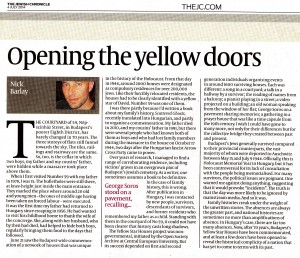
From the ‘London A-Z’ series in The Knowledge section of The Times:
“G for Gangland London”
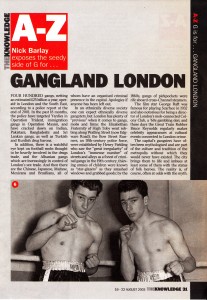
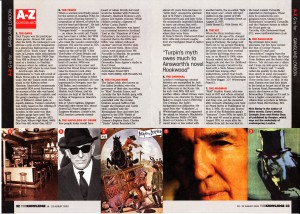
“O for Ordure in London”
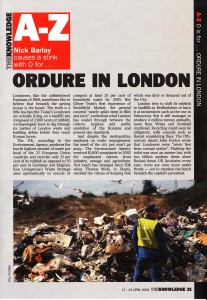
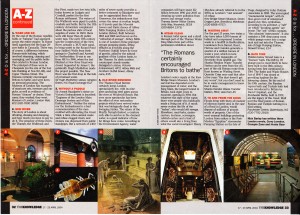
And from the ‘London At Work’ series:
“Private Eyes”
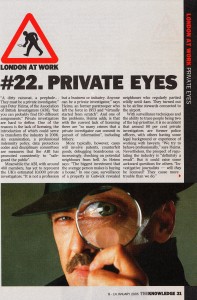
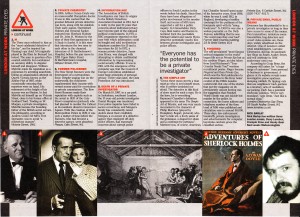
Mr Blowup and Chums – Guardian
Burglary, The Old Fashioned Way – Limb By Limb
Nobody could accuse Calvin Sewell of not being a good listener. But when he carried out a series of burglaries in South London in the late 90s, little did he know that his ear would make legal history.
Sewell had already proved his skill as a burglar many times over many years, netting several thousand pounds worth of property and leaving police flat-footed. The key to his success was his dog-like ability to hear. Pressing his right ear against a door or window was his surefire method of telling of whether anyone was home. But while dusting for fingerprints, scene-of-crime officers began to notice a ‘peculiar aspect’ to otherwise ordinary burglaries: earprints. Sadly for Sewell he was known to police from previous convictions. Police took the unusual and historic step of making an acetate mould of Sewell’s ear. It matched Sewell’s prints conclusively, securing the burglar’s ear a place in the record books and the rest of him a place in prison.
To some this story will confirm the relentless progress of technology, the struggle of science against crime. To others, it will confirm that very little has changed in a burglar’s modus operandum in the 150 years since the first real study of burglars was carried out in Victorian London.
Henry Mayhew’s London Labour and The London Poor was a unique investigation of urban poverty and crime, from ‘they that will work’ via those that ‘can’t work’ to those that ‘won’t work’. It took the author deep into the world of cracksmen, crows, canaries, putters-up, dolly shops, low public houses and brothels. In short, Henry Mayhew went on a ‘ramble among the thieves’.
The array of criminals, miscreants, prostitutes and general dodgy geezers was, of course, not discovered by him. There are sixteenth-century accounts of ‘priggers of prancers’ who stole horses, ‘abram-men’ who faked madness, conmen such as ‘anglers’, ‘rufflers’ and ‘palliards’, and ‘nyppers’ or ‘pickepurses’. The eighteenth-century London underworld was more or less ruled by Jonathan Wild, the self-appointed ‘Thieftaker General of Great Britain and Ireland’. While apparently acting against criminals and sending scores to the gallows, Wild organised an underworld army of thieves, robbers and burglars with an international network of warehouses, receivers and distributors for hooky gear. Here was an official in the crime boss super-league, the Mr Big of his day, the Krays and the Richardsons rolled into one but with a fancy title.
When researching Hooky Gear, a novel about a contemporary London burglar whose life comes apart, I too rambled among the thieves although, unlike Mayhew, I happened to know most of them before I rambled among them. The narrator of the novel, J, is based in part on a real burglar who once pointed out to me: ‘Don’t matter where you are. Gear is gear.’ And from this simple truth the timeless practicalities of burglary fan out. Where to find it, who knows about it, how to get it, what to do with it and when to do it again are the sort of problems with which burglars throughout the ages have grappled.
Their solutions to these problems always begin with a good eye – or ear – for an opening. As Mayhew wrote of successful burglars: ‘They listen at the doors of the apartments, and know by the breathing in general if the inmates are sound asleep.’ According to J, once inside, a house has a key point from which you can hear into every room: ‘Every house has a spot like that, like a navel, like a dead centre.’ To help with the operation, burglars, like the rest of us, get by with a little help from their friends. The ‘cracksmen’ that Mayhew talked to often worked with a ‘crow’ or lookout and, occasionally, a woman known as a ‘canary’ who carried the tools. Typically, then as now, the burglar will look for the easy options: picking a lock with a ‘betty’ or ‘Floyding’ a door with a credit card; jemmying your way in the back or squeezing through an open toilet window, a window that J calls a ‘burglar’s mate’.
More elaborate schemes abound. Take the ‘remarkable case of burglary’ that Mayhew reports being carried out in a fashionable West End house. Two burglars got to know the cook and servant in the house and seduced them both. During the amorous encounters upstairs, downstairs and in their lady’s chamber, the cook and servant failed to notice a third man who made off with the silver.
A modern equivalent might be the case involving a stolen car, a box of chocolates and a pair of theatre tickets. Burglars initially stole the car from the driveway of a large house, then returned it with equal stealth to its owners, complete with the aforementioned chocolates and tickets. An accompanying note mentioned a drastic emergency and apologised for any inconvenience. The owners took the opportunity for a free night out and came back to a free home – free of anything, that is.
Further up the foodchain in Mayhew’s London were the ‘putters-up’, men who organised burglaries on the basis of inside information and would supply the necessary tools for the job. They could also act as receivers or fences, disposing of goods through ‘dolly shops’. These ‘dolly shops’ or pawnbrokers have long been associated with criminal activity. In Hooky Gear, the character of Uncle, a well-known tag meaning pawnbroker, is the young urban ‘putter-up’ and is also based on a real individual.
The average burglar is often caught between the police and men like Uncle. While Mayhew acknowledged the burglar’s manual dexterity and courage, he also conveyed the desperation in the lives of some of these ‘cracksmen’: lengthy prison sentences; wives who died while their husbands were ‘transported’; the endurance test of trying to lead an honest life, of going straight.
If property is nine tenths of the law, then property is also nine tenths of a burglar’s life. And if Mayhew’s case studies or the story of J are anything to go by, a life on the rob or on the drum, with or without the ears of a Calvin Sewell, will always be a pretty desperate affair.
Cold War Bunkers – From ‘Heritage Today’
New global tensions have replaced the Cold War but its bunkers and radar installations remain as unnerving reminders of the age of superpower standoff.
Tiered banks of circular orange radar screens glow in the dim subterranean room. Illuminated overhead boards and maps track aircraft movements from Murmansk via the North Cape down to the Kent coast. Headsets and receivers hang silently by their operators’ chairs, and yellow control panels are alight and ready. This could be the set from Kubrick’s classic doomsday film, Dr. Strangelove. But it’s the all-too-real operations room at one of Britain’s formerly top secret Cold War nuclear bases.
With the Cold War over, English Heritage has taken the lead to ensure that the dwindling legacy of this exceptional period is preserved. A new book, ‘Cold War: Building for Nuclear Confrontation’ by Wayne Cocroft and Roger Thomas, details over a hundred sites around the country. Most, either on Ministry of Defence land or derelict, are inaccessible. But the operations room at RAF Neatishead in Norfolk is beneath one of the few buildings open to the public. To descend into its claustrophobic bunker, in full use until only ten years ago, is to think the unthinkable.
It was from here that, in the 1960s in particular, Neatishead played its essential part in a Cold War air defence strategy known as the ‘Linesman’ project based on the ‘tripwire’ concept. After a massive nuclear missile attack by the Soviet Union, ground radars would warn of the ensuing wave of enemy aircraft thus triggering the retaliatory response of Britain’s V- Force, consisting of Vulcan, Victor and Valiant bombers. In short, this was the doomsday scenario. And Neatishead, according to Wayne Cocroft, was on ‘the front line of the Cold War’.
During the fraught days of October 1962, when the Cuban missile crisis took the world to the brink of nuclear disaster, most bases in Britain were on a heightened alert. Neatishead in particular bore the brunt of front-line tension. ‘Obviously,’ says Doug Robb, manager of Neatishead’s air defence radar museum and a former radar operator, ‘it was a very intense atmosphere… We thought we were going to war.’ More typically, as Robb points out, Soviet aircraft ‘electronically probed our radars to see what was there… It was a game but a serious game and it just went on forever.’
The air defence museum, housed in the same and original 1942 operations building, is replete with the artefacts and paraphernalia of wartime and post-war air defence, charting the evolution of radar from what Robb calls the ‘pretty Heath Robinson’ contraptions of the 1940s and early 1950s, to the digital handsets and consoles of the early computer age. There are also highly accurate Red Army maps of Britain on which Neatishead does not, reassuringly, appear.
The intense atmosphere underground is in stark contrast to the placid RAF base only a few miles inland on the edge of the picturesque Broads. Neatishead’s central nervous system was protected from nuclear strike but its single eye, a huge military-green radar, is unmissable on the carefully chosen low and level landscape. The Type 84 is Britain’s last surviving example and was the longest serving radar in the world, having celebrated its golden jubilee in 1991. It first saw active service as part of the wartime Chain Home radar stations strung out along the eastern and southern coasts. Later it evolved into a key link in Britain’s nuclear response plan, tracking the codenamed ‘Bear’ and ‘Badger’ aircraft of the Soviet enemy.
‘Caelum Tuemur’ – ‘we watch over the sky’ – may be Neatishead’s motto but standing in the radar’s shadow is the second visual clue, if not icon, of Neatishead’s potentially lethal Cold War role. The supersonic Bloodhound surface-to-air missile, originally sited all over East Anglia and controlled from Neatishead, seems too small and compact a rocket to have been the country’s main defence against nuclear bombers and missiles. But its power lay in its proximity fuse designed to detonate near flying targets: As Doug Robb says: ‘Imagine a square mile of sky filled with shrapnel. It would tear everything apart.’
If Neatishead was on Britain’s military front line, then Hack Green, 200 or so miles away in the heart of the Cheshire countryside, was at the centre of the nation’s post-nuclear civil defence and government. Neatishead is to Hack Green what the ‘four-minute warning’ was to the concept of ‘protect and survive’. In other words, Hack Green, also accessible to the public and a highlight of the new Cold War book, was built to last. Sealed behind its massive blast doors and five-foot thick reinforced concrete walls, its staff were meant to survive a one kiloton explosion at 300 metres and temperatures of 350ºC for an hour and a half.
Beneath the 1950s bunker, in a vast two-level, 35,000 sq ft, complex, was the intended headquarters of regional government. Walking through the labyrinthine corridors and interlinking rooms with their preserved equipment and careful reconstructions is, as Cocroft’s co-author Roger Thomas says, ‘one of those sobering sights that makes you stop and think’.
On Level 1, civil servants would have discussed the finer points of nuclear damage, radiation fallout, decontamination, civil infrastructure and public services. Warnings of imminent attack could have been sent to a network of 5000 receivers, and 7000 sirens could have been activated. The communications room was at the hub of the emergency network and ranges from prototype visual display units and teleprinters, to British Telecom’s message switching centre. If necessary, the commissioner – a civil servant or minister with full executive power – could have spoken directly to ‘survivors’ from the BBC radio studio on Level 2.
With its life support systems and huge air-cooling units, it was meant to be home to 135 civil servants who could survive for up to 12 weeks. The conditions were, and still are, basic: 40 general staff, in one female and two male dormitories, would have operated on the ‘hot-bed’ principle, taking the still warm beds of their colleagues after their shifts.
Meanwhile, scientists would detail the size of bombs and scale of fallout in order to advise on refugees and public safety. Calculations would be made on the sloping red plotting tables to ascertain the ‘threat front’, an air or ground burst, and the ‘nuclear burst tote’ in all surrounding sectors. AWDREY might sound like a welcoming member of staff but Atomic Weapon Detection Recognition and Estimation of Yield was central to the business of Hack Green. One room, staffed by a doctor and nurse, is an explicit reconstruction of the effects of nuclear weapons on the human body, showing the ‘severe keloids’ or flesh scarring caused by thermal radiation.
Prolonged work in an intense underground environment was bound to have an effect on staff. By the mid-1980s, planners were wise to this. A complex colour scheme, unlike the standard manilla, grey and off-white, was devised by designers and clinical psychologists. ‘Who they were,’ says Hack Green’s curator Rodney Siebert, ‘is lost in the mists of time.’ But the idea was that red and white would denote ‘busy areas where people needed to be kept active’ and pale blue and green would serve for rest areas such as the dormitories. The only remaining part of the scheme is the bright yellow of the stairwell. ‘It was meant to keep people from suicide,’ says Siebert. ‘But it was never put to the test.’
By then, the Cold War was thawing. Barely twenty years on, Hack Green is thought by Wayne Cocroft to be ‘the best Cold War museum in England’, complete with Soviet uniforms, heat resistant suits, East German ‘morsegeber’ communications equipment, once secret British government films, geiger counters and even decommissioned strategic thermo-nuclear weapons.
Together, Neatishead and Hack Green, with their military and civil priorities, provide an intricate national archive. As Rodney Siebert says: ‘The main importance is that there’s a physical record of the work done by the many thousands of individuals who kept the Cold War going.’ These days, there are only a few individuals to keep at least the memory of the Cold War going. And there are even fewer surviving buildings to evoke the age of the four-minute warning and the madness of mutual assured destruction. Without them, we might forget what it was like to think the unthinkable.
Around the world on 80 pence – From ‘Time Out’
The trouble with trying to travel on the cheap is that it all too easily becomes a psychosis before you’ve even started travelling. You just have to have everything for as little as possible, next to nothing, certainly cheaper than the Joneses, so cheap, in fact, that can you assure yourself you would have spent more had you stayed home in front of the tele.
As a result, everywhere there are would-be travellers searching through bookshops for expensive, supposedly money-saving, travel bibles: Brunei on Fifty Pence a Day; New Bond Street on a Shoestring; Surviving the Jungle on an Elastoplast; Budget Dining with the World’s Arms Dealers. Alternatively, they scour newspapers for tokens, coupons, discount advertisements and special week-by-week cut-and-keep offers for places they’ve never heard of, and into which they certainly couldn’t stick a pin on a map. But apparently they’re cheap.
Having found a printed promise of a bargain, they sign up for charters, packages, clubs and all-in expeditionary forces where their money has been spent in advance making local deals over which they have no say. Then they complain that they never got to know the locals because there were too many English-speaking people on the trip – most of them were probably on the same coach and beach or in the same cheap hotel, cut-price condo or ‘authentic’ safari-adventure jeep.
On the other hand, the long-distance or long-term traveller takes a somewhat different approach. A travelling friend, who settled for a while in Cairo, was once asked by an English tourist what the cheapest worthwhile experience in town was. ‘I am,’ he answered. With that simple, sufi-like, attitude you can travel the world, as both he and I have, for less than anyone. After all, if you come cheap, you will always travel cheap.
Now that you’ve reevaluated what your life is worth, take the following in to consideration:
1. Ways to travel
Reading a headlining transport disaster while slouched in an armchair makes most people sit up and think. You can almost feel entire South American rainforests being chainsawed for safety campaigners’ press releases. But if you are truly cheap, you will never hamper your schedule with risk assessment or feasibility studies.
When I set out for an eighteen-month overland journey across Asia, I started by buying a coach ticket from King’s Cross to Istambul. The deal was the cheapest and, of course, the best. So cheap and so good was it that the coach crashed in Italy, mainly because the drivers were changing places while doing seventy in the middle lane of the autostrada (a full refund was given). I’ve travelled on rickety trucks along tortuous mountain roads with a cargo of gasoline and a crew of chain-smokers (no charge); in aeroplanes where live chickens were stacked in the overhead lockers and a goat roamed freely in the aisle checking people’s seatbelts (forged ticket); on cross-river ferries where passengers had to help bail out water (they only tried to charge a deposit on the bucket); a dawn newspaper train (free in the coal wagon); a sharabang across the sub-zero night-time desert (free strapped to the roof).
So, without detracting from the noble cause of safety crusaders, the cheap traveller knows what every transport official across the globe knows, namely, that safety has to be built in to the cost of the ticket but no matter how much more the ticket costs accidents will happen. In other words, from the narrow statistical viewpoint of the cheap traveller, the world is as good as risk-free.
2. Places to stay
Book ahead, they say; get to know the guy at your local bucket shop, they advise; you must stay at this fantastically cheap hotel, your friends boast. But the fact is that, if a hotel is truly cheap (like cheap traveller cheap) you won’t find it in a brochure, be told about it by the travel agent, and even your friends won’t admit to having stayed there. The point is, cheap travellers never book hotels in advance. They stumble in to the foyer at the dead of night when the concierge’s bargain-resistance factor is at its lowest.
Besides, I would never have booked a room at the Hotel Swastika in Haridwar, not only because it would have seemed a too-high-risk venue for a Jew but also because it was strangely absent from the brochures. Cheaper places do, inevitably, exist. I have slept in a resplendent marble hall (Moscow underground); an unattended first-class railway carriage (Beijing station); a disused shack with mountain view (Hindu Kush). And if you fail to find such abodes, there’s always sleeping rough…
3. People to meet
Meeting people is especially important to the cheap traveller. This is because one of the cheapest places to stay is in someone else’s home. To do this, you must have reasonable inter-personal skills and no particular odour.
I must have met these simple criteria when I was invited out of the monsoon to stay at the Catholic Women’s League in Manila. Of course there was a trade-off for being the only male in the place: I had to be a Christian three times that week during bible class. Then there was the policeman and his sister in Alexandria. I could stay as long I promised to marry her. I have yet to marry so the promise remains unbroken. Then there was the vodka-drinking communist with whose family I stayed in Teheran. Vodka-drinking communists are wonderful people the world over but in Iran even a cheap traveller has to question the sanity of accepting their hospitality. (He was later arrested and publicly beaten by the Revolutionary Guard.) Still, there’s nothing like freeloading.
4. Things to do
For the cheap traveller, the notion of ‘doing’ has less to do with an itinerary of ‘must-sees’ than with finding ways of extending travelling time. Here are some possible alternatives to freeloading and begging. Buy a fake student card; smuggle guns and drugs; or, if you’ve decided to settle somewhere, sell your passport. I have been offered the opportunity to smuggle gold, drugs, watches, precious stones and whisky, and to participate in stacked poker games and credit card fraud.
For the less criminal-minded, you can always do what Susan from Sidcup did. On her travels, she met and fell in love with a man from Bengal and they ran off to the Manali hills to make peanut butter together. As far as I know, she’s still there, producing the best and cheapest peanut butter with no additives or preservatives. Not even Club Med could promise romance like that.
5. Things to take
For the cheap traveller, this section is necessarily short. First, because anything you can buy here, you can also buy there, only cheaper. Second, because walking around with a stuffed multi-storey rucksack gives thieves the wrong idea, ie that you have something worth stealing. The principle to guide you through packing is the three-sock principle. According to this, you only need three socks for your trip. That’s not three pairs but three, individual, socks. These can then be rotated clockwise or anti-clockwise between feet so that you will always have one clean sock, one relatively clean, and only ever have one sock to wash or air at a time.
Cheap travelling as practised by the true masters is more a state of mind than a question of following the footsteps of jaded travel writers. Since any and every experience can be equally enlightening, it really doesn’t matter how much or how little you spend. The truly cheap traveller will always see money as an unnecessary irritation, just another thing to pack and to take care of. Far better to climb aboard the gasoline truck, ask for a light, and drape your just-washed sock on the windscreen. Statistically, you will live to tell the tale. And even if you don’t, it hardly cost you a penny.






